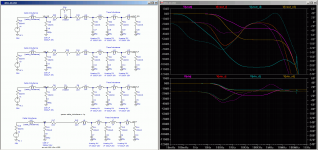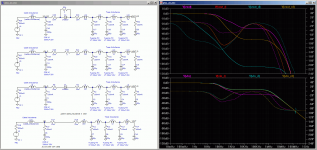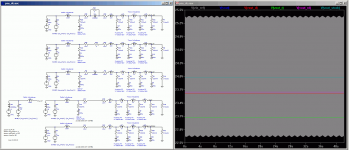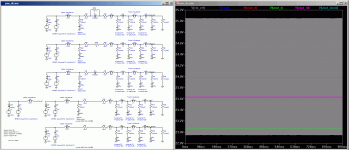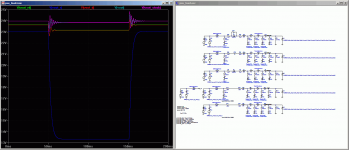Hi all love this site, Lots of good info
So i,ve been putting a circuit board together but having problems with interference to my DAB radio in same box, here is a pic off pcb if u can see a problem please comment
The circuit is to IT spec sheet
Thanks !
View attachment 537373
There is a lot of radio noise emission from class D. I you problem radio inference? Depending on your frequency of interest the TPA311x has resistor jumpers to select the carrier or modulation frequency between 400kHz and 1.2MHz. Probably best not to put them in same enclosure.
Nice SMT board.
I'm still confused by how Daniel's C+Diode (which is what it looks like in the pic he posted) implementation on the power input is a CRC implementation as he claims.
Hi guys. I need some advice about power supply.
I'll use 2 x Sunwa TPA3118 PBTL 60W Mono DC 8-24V T8L9 amp boards.
What is the best practice to connect a power supply to 2 mono blocks amp?
Should I use seperate power supply or one 24V MAX 9A 150W Regulated Transformer just enough?
Thanks for advice.
I'll use 2 x Sunwa TPA3118 PBTL 60W Mono DC 8-24V T8L9 amp boards.
What is the best practice to connect a power supply to 2 mono blocks amp?
Should I use seperate power supply or one 24V MAX 9A 150W Regulated Transformer just enough?
Thanks for advice.
I'm still confused by how Daniel's C+Diode (which is what it looks like in the pic he posted) implementation on the power input is a CRC implementation as he claims.
To make the short answer long:
Lets compare:
- Resistor + Diode + big bulk cap
- Resistor only + big bulk cap
- Diode only + big bulk cap
- direct connection + big bulk cap
- stock (no R, no D, no bulk)
An AC-analyse provides:
Without cable inductance from power supply:
With cable inductance from power supply:
What can be seen? R and R+D is similar/same at AC - we will see, that this isnt at DC. The diode only plot lacks from the simulation modell i guess.
The cables inductance takes place at frequencies from 1MHz and up.
So whats happening on DC. Lets assume PVCC=24V, PVCCripple=1Vp, constant load of 11.5W (Rload = 50R)
at 100Hz:
at 1kHz:
at 10kHz:
at 100kHz:
Vinref is the voltage (with ripple) feed in into the power path. It can be seen that the "resistor only" variant has the least ripple but bigged voltage-drop. "Diode only" and "Diode + Resistor" are pretty much the same for frequencies <10kHz, things getting worse for frequencies of 100kHz and up (for the "diode only"). Having just the bulk cap, voltage levels stay ~the same as stock with bit better ripple reduction.
Compared "just bulk cap" with "bulk cap + R + D", "bulk cap + R + D" is better at the cost of 0.4V drop.
Better means 10mVripple vs. 20mVripple.
Lets see this in percent from 24V supply voltage:
"just bulk cap": Vripple=0.083%; Vdrop=0.08%
"bulk cap + R + D": 0.042%; Vdrop=1.6%
Having a load step of 120W (5A) at the rail:
It can clearly be seen, that having an just an R of 2Ohm between the caps is a real deal breaker. Diode and Diode+Resistor are performing nearly the same with some voltage drop (of course).
Having the big bulk cap in the system dampens out the peaking of the connection wire but wont help on a load step, as the voltage drop is dominated the power supplies impedance.
My own conclusion from the simulation:
The advance of using an R+D + bulk cap is negligible. If doing so, the inflluence of R (at 2R) compared to the diode only is also negligible.
The bulk cap is helping to bring down the systems impedance when having long wires/connections to the PSU (This is a commonly fact) and helps to reduce "ringing" from the connections inductance. If you have short low impedant connections, the bulk caps influence is also negligible.
While the diode or resistor+diode decreases the ripple by about 50%, we are talking about ripple levels of 40mV (with a stimulus-ripple of 1Vp) and down which are below 1% of the supply voltage. Would you use a supply with 1Vp ripple on the output?
So if there is an audible effect, this either is biased or the supply from "non-optimal" quality/performance.
At bass levels the bulk capacitance is way to low.
For thos who like, the simulation files are attached.
YMMV.
Regards.
Attachments
Last edited:
Thanks again for your help,
and I have some notes:
A ferrite (such as FB43) needs placed in-between diode and big cap.
The bypass R needs deleted--that part is junk.
Much more capacitance can be used--I should have doubled it.
I used a laptop pack with 18.5v of mostly DC output.
The board already had a schottky, so please sim at 0.9vdrop (total) because that will make significant difference to effectiveness.
I expected the simple device to do an incomplete job, in the form of a little step in the right direction, at a very low cost. That worked, a bit.
By how much? Here's a sample: When I applied this to the TDA7293, the stability maintained better at maximum output, so that I was able to set the gain 2x lower. That isn't a lot of help, but it didn't cost much either. TPA3118 exhibited similar performance, when after the inexpensive mod, it could be cranked up louder without the tone/stability souring.
At the point of no souring, the two devices were worth their price. As far as explaining decoupling forced to work correctly, nobody has managed it yet and I am not the exception.
and I have some notes:
A ferrite (such as FB43) needs placed in-between diode and big cap.
The bypass R needs deleted--that part is junk.
Much more capacitance can be used--I should have doubled it.
I used a laptop pack with 18.5v of mostly DC output.
The board already had a schottky, so please sim at 0.9vdrop (total) because that will make significant difference to effectiveness.
I expected the simple device to do an incomplete job, in the form of a little step in the right direction, at a very low cost. That worked, a bit.
By how much? Here's a sample: When I applied this to the TDA7293, the stability maintained better at maximum output, so that I was able to set the gain 2x lower. That isn't a lot of help, but it didn't cost much either. TPA3118 exhibited similar performance, when after the inexpensive mod, it could be cranked up louder without the tone/stability souring.
At the point of no souring, the two devices were worth their price. As far as explaining decoupling forced to work correctly, nobody has managed it yet and I am not the exception.
So voltage down to 17.6V and lower on higher levels? For serious listening I am a little below that.
I don't find your too loud treble and would look at output for that, not input.
Compared today to a full digital commercial respectfull brandname 1000 euro plus amp, bass of that amp is far weaker than any 3118/16, bass is far less detailed/controlled too. Mid/treble poor imo compared to the 3116 I listen to and 3118 gmarsh. So keep major hifibrand offerings in mind when saying a $2.75 chinese amp isn't bringing what was expected, these major hifibrands offer products that are inferior in almost every way above 1000 euro. Chipsets similar to Hifimediy full digital amp (ST Micro DDX), which has slightly better bass than the hifiname one and far better mid and treble.
I don't find your too loud treble and would look at output for that, not input.
Compared today to a full digital commercial respectfull brandname 1000 euro plus amp, bass of that amp is far weaker than any 3118/16, bass is far less detailed/controlled too. Mid/treble poor imo compared to the 3116 I listen to and 3118 gmarsh. So keep major hifibrand offerings in mind when saying a $2.75 chinese amp isn't bringing what was expected, these major hifibrands offer products that are inferior in almost every way above 1000 euro. Chipsets similar to Hifimediy full digital amp (ST Micro DDX), which has slightly better bass than the hifiname one and far better mid and treble.
So voltage down to 17.6V and lower on higher levels? For serious listening I am a little below that.
I don't find your too loud treble and would look at output for that, not input.
Compared today to a full digital commercial respectfull brandname 1000 euro plus amp, bass of that amp is far weaker than any 3118/16, bass is far less detailed/controlled too. Mid/treble poor imo compared to the 3116 I listen to and 3118 gmarsh. So keep major hifibrand offerings in mind when saying a $2.75 chinese amp isn't bringing what was expected, these major hifibrands offer products that are inferior in almost every way above 1000 euro. Chipsets similar to Hifimediy full digital amp (ST Micro DDX), which has slightly better bass than the hifiname one and far better mid and treble.
Would you mind saying which 100 EUR hifi amps you are comparing against or have listened to and determined that the 311x's are better? I don't doubt it, I just am surprised the price range is in the 1000 EUR. I would have guessed maybe 500 to 600 EUR range. Are the commercial offerings class AB or class D?
I am having an enjoyable time listening to Destroyer X's Dx amp. It seems to have better bass to my ears (and measurements show a little more extension) and mids and highs are quite lovely. As a class AB amp with big fat TO3P BJT power transistors, don't you think the current carrying ability is better than a pinner little transistor buried somewhere inside that micro chip? I think you mention damping factor may have something to do with the ACA class A, but what about Dx? Is the damping factor responsible for the fuller bass? Less control maybe is why it sounds more full?
This doesn't lack for bass and it doesn't lack for lifelike dynamics. Do you happen to have 4*470 caps to replace the smaller caps onboard? We may need to apply some suppression so that what we wanted to hear is easier to do.
This does not lack for bass power, it doesn't lack for resolution and it doesn't lack for lifelike dynamics even at the lowest gain setting. The remainder may be louder, which is distracting. Let's try to reduce what it can't do well and then see what happens.
This does not lack for bass power, it doesn't lack for resolution and it doesn't lack for lifelike dynamics even at the lowest gain setting. The remainder may be louder, which is distracting. Let's try to reduce what it can't do well and then see what happens.
Can't name brand at this moment, full digital is digital signal to class D driver chip, no coupling caps on input or elsewhere in digital signalpath, I didn't listen to analog input, above 1000 euro, but US dollar price might be lower, don't know. The Hifimediy spec is 2x100watt, so power spec of hifibrand model is close to that. Same tiny transistors and pins as tpa3251 and tpa3118, I don't think amount of plastic or metal surrounding tiny dies matters much.
Attachments
Last edited:
They're aB amplifiers, mainly TurboSound, if you need trouser-flapping power and still easily talk over it. I did one, but I'd rather not do it again because the labor was so bad; so I refer requests to my very competent competitor, TurboSound. There's nothing like it, except for mine. And, I'm not willing to do that again. It is a big job and that is very annoying to do. That scale is not usable in a house.Would you mind saying which 100 EUR hifi amps you are comparing against or have listened to and determined that the 311x's are better? I don't doubt it, I just am surprised the price range is in the 1000 EUR. I would have guessed maybe 500 to 600 EUR range. Are the commercial offerings class AB or class D?
I'd much rather do something that works in my house.
Please tell us if the difference was located at the baritone. Even after other means, I have been annoyed that the baritone range was insufficient. That indicates that the power decoupling scheme has not worked well enough. So, I'd like to know.I am having an enjoyable time listening to Destroyer X's Dx amp. It seems to have better bass to my ears (and measurements show a little more extension) and mids and highs are quite lovely. As a class AB amp with big fat TO3P BJT power transistors, don't you think the current carrying ability is better than a pinner little transistor buried somewhere inside that micro chip? I think you mention damping factor may have something to do with the ACA class A, but what about Dx? Is the damping factor responsible for the fuller bass? Less control maybe is why it sounds more full?
Greater negative feedback = more suppression of sonic signature.Dynamics 3116/18 in 20dB settings are better than in higher gainsettings
I'm glad that you spotted it. I'm not in favor of that approach unless it has worked. So, I'm glad that you have mentioned it. I liked the lower gain setting, personally.
I would like a more thorough comparison between the 20db versus the 26db settings, because I'd like to know. Which is better?
At that price point, you might want to spend for a more competent speaker, because that will be more effective than amplifier differences.Can't name brand at this moment, full digital is digital signal to class D driver chip, no coupling caps on input or elsewhere in digital signalpath, I didn't listen to analog input, above 1000 euro, but US dollar price might be lower, don't know. The Hifimediy spec is 2x100watt, so power spec of hifibrand model is close to that. Same tiny transistors and pins as tpa3251 and tpa3118, I don't think amount of plastic or metal surrounding tiny dies matters much.
Perhaps I should have used different language for that? Help?
Please tell us if the difference was located at the baritone. Even after other means, I have been annoyed that the baritone range was insufficient. That indicates that the power decoupling scheme has not worked well enough. So, I'd like to know.
Yes, it was stuff below 150Hz - just seemed a lot richer and more present.
I don't think amount of plastic or metal surrounding tiny dies matters much
But the thickness of the pins leading from the die can carry more current, no? Plus no output inductor to squeeze all that current through. I bet the physical transistor size (active element) of a Toshiba 2SC5200/2SCA1943 is bigger than what is used in a TPA31xx.
Last edited:
Replacing 4*330uf for 4*470uf changes "nothing".
For low frequencies way to less, at high frequency ESR dominates.
For low frequencies way to less, at high frequency ESR dominates.
Okay, the power decoupling on this Sanwu TPA3118-PBTL board is insufficient, and I can't fix that with an easy add-on. We'll have to change the caps on that board. So, if you wanted it relevant, then you'll have some soldering to do.Yes, it was stuff below 150Hz - just seemed a lot richer and more present.
Oh hey! Yeah, that. Well, it changes a little, and that's the little that we probably need. Is it about time to explore the output filters? What should I do next?Replacing 4*330uf for 4*470uf changes "nothing". For low frequencies way to less, at high frequency ESR dominates.
Can we (the a bit less pro- public) expect a wiki for modding this board like it exsists for the blue tpa3116? Would be really great🙂
Poslano z mojega LG-D855 z uporabo Tapatalk
Poslano z mojega LG-D855 z uporabo Tapatalk
My comment is meant for specified components. 😉
But yeah, changing a 330uF cap with an ESR of 200mR for a 470uF with an ESR of 35mR will change a lot, but only because the better/lower ESR.
And then.. welcome back to cap-rolling. So better measure, model, simulate, verify with real parts and finally compare. But really first describe the problem, relate it to practical demands and understand how parts/dimension fix it to the better. 🙂
Why is it insufficient and what's "the needed little"? May you describe it more technically so there's a way it can possibly be fixed?
But yeah, changing a 330uF cap with an ESR of 200mR for a 470uF with an ESR of 35mR will change a lot, but only because the better/lower ESR.
And then.. welcome back to cap-rolling. So better measure, model, simulate, verify with real parts and finally compare. But really first describe the problem, relate it to practical demands and understand how parts/dimension fix it to the better. 🙂
Okay, the power decoupling on this Sanwu TPA3118-PBTL board is insufficient...
Oh hey! Yeah, that. Well, it changes a little, and that's the little that we probably need. Is it about time to explore the output filters? What should I do next?
Why is it insufficient and what's "the needed little"? May you describe it more technically so there's a way it can possibly be fixed?
Last edited:
I really hated to report that it might be necessary. Sorry for that. The purpose of the circuit is to defeat cap rolling. I don't want to need it. So, when that little circuit hasn't worked, it means that cap rolling won't work either. We just need bigger caps, of relevant quality, which is rare in larger sizes. It isn't nice to have that need.But yeah, changing a 330uF cap with an ESR of 200mR for a 470uF with an ESR of 35mR will change a lot, but only because the better/lower ESR. And then.. welcome back to cap-rolling.
It didn't need much, but it was needy! Decouplers also perform suppression of sonic signature at some cost to also suppressing some portion of valid signal. I have failed to arrange a better fix, and I didn't want to report that the case has needed greater suppression. The ugly fact is that it may have that need. We have to check to see if there is a better locale for this fix. And, if there wasn't, then let's haul off and do an available fix, so that we can see if it was enough.Why is it insufficient and what's "the needed little"? May you describe it more technically so there's a way it can possibly be fixed?
Maybe this can do real hi-fi? I haven't found out yet. It does get close. We should help it so we can find out.
Last edited:
- Home
- Amplifiers
- Class D
- Cheap TPA3118D2 boards, modding them and everything that comes with it
